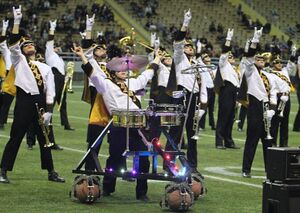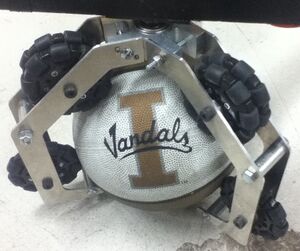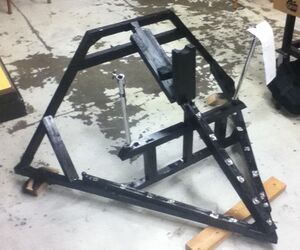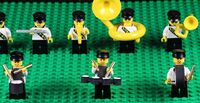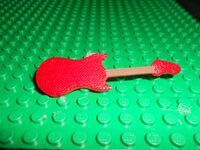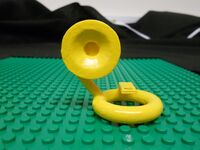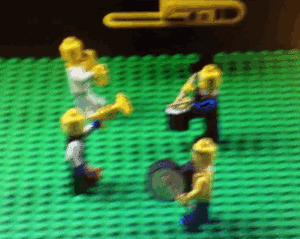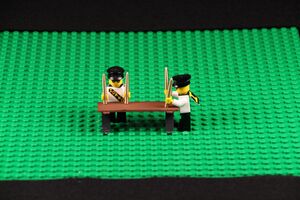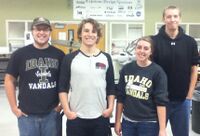|
|
|
|
| Finale for a halftime performance
(photo courtesy of Meredith Metsker)
|
| Sponsors
|
|
| Team Name
|
The Band-Beesten Experience
|
| Duration
|
Fall 2013 - Spring 2014
|
| Faculty Advisers
|
- Dr. Steve Beyerlein
- Dr. Edwin Odom
- Russ Porter
|
| Mentor
|
|
| Team Members
|
- Scott Blee
- Jack Housley
- Nadine Morasci
- Theodora White
|
| Previous Team
|
- Jonathan Rompala
- Miguel Martinez
- Hayden Hanzen
|
This is the continued interdepartmental effort to both create a fully mobile drum set for use by the Vandal Marching Band and market the efforts of the University of Idaho's Mechanical Engineering Department. Current design goals for the Band-Beesten focus on decreasing weight and Omni-ball friction while allowing for a wider variety of instruments to be used, as well as market the work done by the engineering team by creating a video to show off the UI Marching Band.
Background
The original idea for the project began a few years before the Fall of 2011 by Dr. Edwin Odom, Professor of Mechanical Engineering, and Dr. Daniel Bukvich, Professor of Percussion and Music Theory. The plan was to collaborate between their disciplines and create a finely tuned, expertly engineered drum set that is fit for a full on-field marching band performance.
The Fall of 2011 marked the initial experimentation and design of the Beest by a Capstone Design team in the engineering department. These initial tests provided insight on what worked well and what needed improvement. The final design from this year was never seen outside of the engineering buildings on campus, but the following year's goals were clear and a new design began immediately. For more in depth design details refer to the Team Drum Roll webpage.
The Fall of 2012 marked the first public introduction of the Beest, which has become a yearly project in the Capstone Design process. Dan Mathewson, a University of Idaho graduate student, designed and utilized a robotic, power driven front wheel that responded to the drummers input and included brightly lit led's on the forward facing drums. It successfully astounded the audience and fulfilled the requirement of marching with a wheeled drum set, but it could still be improved. Dan's thesis can be found in the References section.
The Beest was successfully used during the last two home games of the 2013 football season with the new omni-wheels working as intended. The future of the project will entail designing a lightweight, efficient frame that can be easily dismantled for easy storage by the marching band as well as creating a stop-motion video of the halftime show using Lego to be used for marketing purposes.
Return to contents
Design Goals
First Semester
- Create a mobile drumming platform to be used in time by the UI Marching Band in its last two halftime shows.
- Drumming platform must be able to move in any direction easily solely from drummer input.
- Drumming platform must carry at least 6 different instruments to out-show the quad drums.
- Create a Txalaparta and four mallets to be used in time by the UI Marching Band in its last two halftime shows.
Second Semester
- Re-design the chassis for the Band-Beesten drumming platform to be lightweight and collapsable.
- Create a marketing video for the UI Marching Band featuring the Txalaparta and Band-Beesten out of Lego.
- Create 3D printed models of each instrument used by the Band and recreate the UI halftime show out of stop-motion Lego.
Return to contents
Completed First Semester Design
| Photo
|
Overview
|
|
|
Full Assembly
- Overall weight: 100lbs
- Painted wooden frame
- Three rotating Omni-Ball assemblies
- Three battery powered LED light strips with manual control switch
- Drums mounted to one central location
- Movement via push or pull from the back end
- Videos:
|
|
|
Omni-Ball Wheel Assembly
- Designed based on results from the Friction Testing
- Basketballs used for grip on multiple surfaces
- Surfaces included: hard floor, asphalt, turf etc.
- Three sets of double omni-wheels at 50o
- Three single omni-wheels
- Three identical interchangeable arms
- Attached to hub with pins for easy removal
- Each supported by two shoulder bolts and three regular bolts
- Hub had a press-fit bearing at its center
- Document Archive contains full drawing package
|
|
|
Frame
- Strong pyramidal shape
- Wooden, painted glossy black
- Had central drum support near center of gravity
- Cymbals mounted to separate drum bar
- LEDs powered by seven rechargeable batteries
|
Return to contents
Video Design Specifications
- Lego Scale Props Needed:
- One Marching Band Bass Drum
- Two Guitars
- One Set of Quad-Drums
- Two Saxophones
- Three Trumpets
- One Snare Drum
- One Model of Previous Band-Beesten
- One Model of Txalaparta
- Lego Figure Pieces:
- Eight Plain White Lego Figure Torsos
- Eight Black Lego Figure Legs
- Eight Lego Heads with Sunglasses
- Eight 'Idaho' Decals for Uniforms
- Eight 'Idaho' Capes for Uniforms
- Eight Lego Hats
- Lego Set Pieces
- Black Felt Backdrop
- Base Lego platform
- General Video features:
- Video must be shot in at least 10 Frames per Second.
- Video must encompass some form of each aspect from the actual halftime show video.
- Strong focus on the Txalaparta
- Blend real life with the 'Lego World.'
- High enough quality to be used by the UI Marching Band during video entrance of future halftime shows.
Return to contents
Instrument Design
| Photo
|
Modeling Lessons Learned
|
|
|
Quad-Drums
- Do not make small openings in the solidmodel or else they will be filled with support material that is very difficult to remove cleanly.
- Double check all measurements from Lego people to insure that drums are proper distance away from body and neck hole uses a proper tolerance.
Snare Drum
- Eliminate small openings similarly to the quad-drums.
- Due to the short arm length of the Lego figures, keep drum head no more than 3mm out from harness.
Bass Drum
- Less open space to be filled, thus it needs less support material.
- Keep the thickness no more than 5mm to allow for sufficient drumming motion from the Lego player.
|
|
|
Guitar
- Created using several splines to imitate the look of an actual guitar.
- Neck of guitar made to fit into the hand of a Lego figure to allow extra movement during filming.
|
|
|
Sousaphone
- One of the first printed pieces, this instrument made it clear that there needed to be some way of attaching instruments directly to the Lego figures.
- Due to the intricacy of the bell, the MakerBot was the only available 3D printer that had the proper resolution to make it come out clean and unbroken.
Trombone
- Difficult to adequately print both the bell and the hand attachment portion without failure occurring in the printing process.
- Bell thickened to prevent breaking during printing to 1mm.
Trumpet
- Many of the intricate parts of the trumpet were far too small to print.
- Biggest lesson learned from this piece was to simplify all the designs. The MakerBot simply doesn't have the resolution to add these small details.
|
|
|
Beest
- Beest was originally modeled with all accessories, however they were far too small for the MakerBot to adequately print. They were then removed and the core drums were strengthened.
- Originally printed use the SkyForge 3D printer, however it came out broken and with far too much excess support material to adequately portray the Beest.
- The balls that the Beest stands on were originally too smooth for the MakerBot to print without failures occurring, so the tops and bottoms of the balls were flattened into cylindrical shapes to aid the printing process.
|
Filming
| Photo
|
Filming Notes
|
|
|
Practice Shoot
- The set was made up of one solid green Lego platforms piece surrounded by black fabric.
- Ambient lighting was blocked out and overhead lights shut off. Small Studio lights were used as main lighting source.
- Tripod set up with extra weight to keep it still and prevent small movements. Tape markings were also set at each of the legs to allow for adjustments if the tripod was accidentally moved.
- Shooting was done was done at an average of 10 frames per second.
- A pre-shoot was done to test settings and feasibility of full video.
- Pre-shoot showed the length of time shooting a 5 second video would take as well as the amount of frames to expect.
- During the pre-shoot, it was discovered how easily the program used can loop segments. Using this looping technique drastically cuts down on shooting time if done correctly.
- Looping is done by copying the frames wanted for looping and then pasting them back into the video in the opposite order. This can be done several times to simulate continuously playing an instrument.
|
|
|
First Scenes Shot
- First scenes shot were for of the Txalaparta being played.
- A change of zoom was attempted midway through the shot for aesthetic purposes.
- An extra movement was added to the playing animation where one of the players moves to the side of the txalaparta.
- Second scenes shot were of the two guitar players.
- Originally just supposed to be only playing the guitar, but an extra guitar smashing segment was added on the spot.
- Third Scene shot was of the drumline playing.
- Unmoving extras were added in the background to prevent the scene from looking too bare.
- This scene was one of the most heavily looped.
|
|
|
Final Scenes Shot
- Try to have a spare battery on hand when shooting to avoid down time for recharging.
- Fourth scene was of each Lego figure leaning forward and back continuously.
- Fifth scene was of the Lego figures simulating a 'horns up' by the band.
- Sixth scene was of the Beest charging through six other figures playing.
- This scene was originally going to have the Beest charge through a pyramid of people, however limitations of the set and software prevented this from being feasible.
- Seventh major scene was of the entire Lego band playing in a manner similar to the actual marching band halftime finale.
- Two takes were done of this one. The first was over the top and comical, while the second was a much cleaner and serious shot.
|
Return to contents
Final Product
We will post a link to the final video product here once it has been completed
Included is a short video showcasing the Txalaparta that was created for use by the Vandal Marching Band.
University of Idaho Marching Band Txalaparta Project
Return to contents
Team Members
| Photo
|
Members
|
|
|
Pictured from left to right:
- Theo White, M.E.
- Jack Housely, M.E.
- Nadine Morasci, M.E.
- Scott Blee, M.E.
|
Return to contents
Document Archive
2014 Engineering Expo Poster
Friction Testing Report
Friction Testing Results
Omni-ball Drawing Package
Finale Photo
References
Team Drum Roll, 2011
Band-Beesten news story, 2012
Dan Mathewson's Thesis
